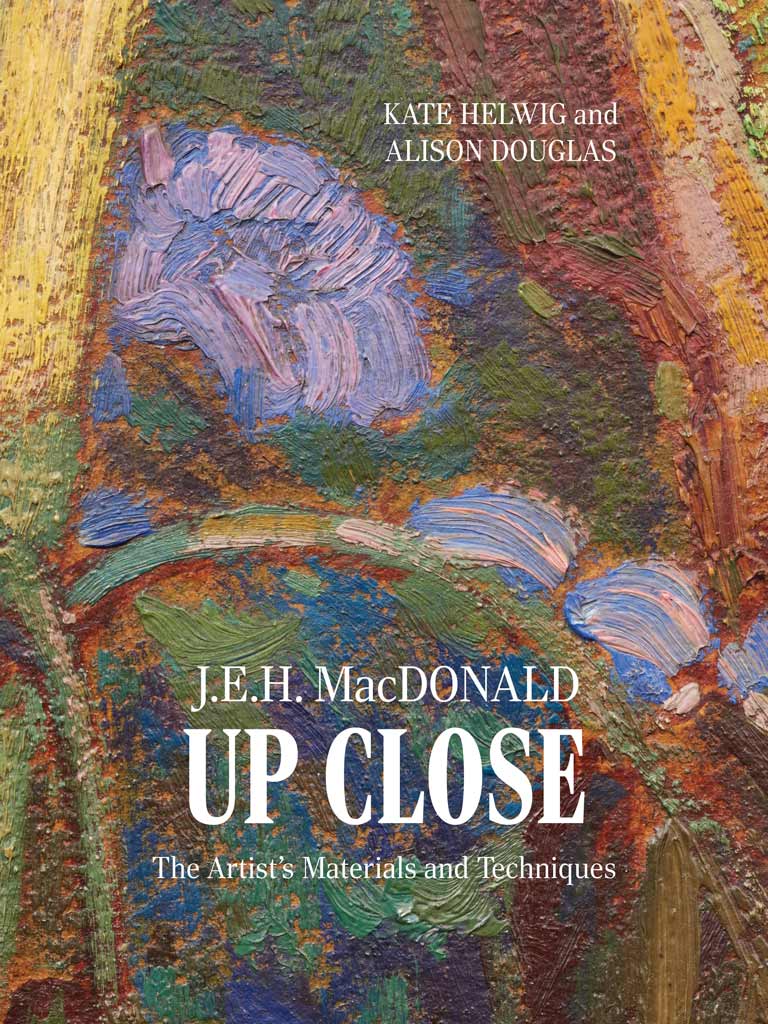J.E.H. MacDonald Up Close

J.E.H. MacDonald Up Close: The Artist’s Materials and Techniques
by Kate Helwig and Alison Douglas
Goose Lane Editions
216 pages, $35
This is an exceptionally interesting book where history and science come together. For any serious collector of art, this book is a must-read.
The authors, Kate Helwig and Alison Douglas, come from the scientific side of art history. Douglas, a conservator at the McMichael Canadian Art Collection, and Helwig, a conservation scientist at the Canadian Conservation Institute, view art through a different lens than simply the eye of someone who has seen a lot of art. The authors take on the long-standing tension between art experts who rely on their keen eye and the scientific experts who deal with scientific facts.
But to enjoy the book, one must first know something about J.E.H. MacDonald, a co-founder of Canada’s famed Group of Seven. James Edward Hervey MacDonald (1873– 1932) was an illustrator, an artist of remarkable talent, and a contemporary and friend of Tom Thomson, who, like MacDonald, died young. MacDonald wrote Thomson’s powerful eulogy and designed the estate stamp that is used to authenticate Thomson’s surviving sketches.
Then one would need to weave in the story of early twentieth-century sketches by MacDonald that had allegedly been buried in a garden north of Toronto, where they supposedly rested for some decades before being miraculously resurrected, sold to a well-heeled collector of Canadian art, and subsequently donated to the Vancouver Art Gallery in 2014. It’s a slightly exhausting story.
Controversy follows the exhaustion. The careers of a couple of prominent art historians took a beating after they had attested to the authenticity of the questionable works. Marsha Lederman of the Globe and Mail courageously pursued the story for years, swelling the controversy.
In 2023, at the end — or at least the temporary end — of this exhausting story, Lederman was shown to be correct in having doubted the sketches’ authenticity, and the Vancouver Art Gallery bravely announced that these beautiful treasures were, in fact, forgeries. So why does this book matter after the fact?
With 7 uniquely curated newsletters to choose from, we have something for everyone.
The art historians whose reputations took the beating along the way relied on the eye and not on science, as is usual practice. The book J.E.H. MacDonald Up Close goes beyond the eye to delve into the science of chemical analysis of paints, canvas and boards, varnishes, techniques, and signatures. This is the heritage of Nathan Stolow, who was appointed in 1956 by the National Gallery of Canada as a “scientific advisor” — perhaps the first of his kind in major art galleries.
The book by Helwig and Douglas also offers a captivating history of the life and work of J.E.H. MacDonald. The Vancouver Art Gallery affair was not the first time his remarkable talent had been the target of forgeries.
In the early 1960s, Ward-Price Auctions in Toronto offered fifteen pictures represented as MacDonald’s work. That auction evening featured a very vocal challenge by Elizabeth Kilbourn, the Toronto Star’s art critic, who demanded of Ben Ward-Price, the auctioneer, to know where the paintings had come from. They were all fakes.
After I wrote The Great Canadian Art Fraud Case: The Group of Seven and Tom Thomson Forgeries (published in 2022), collectors wanted to know what they could do to participate confidently in the art market. I always answered, “Trust the most reputable dealers and auction houses and rely on science.”
J.E.H. MacDonald Up Close is an excellent book based in outstanding scientific research. One of Canada’s preeminent art scholars, Charles C. Hill of the National Gallery of Canada, has applauded the book’s “contribution to the literature on Canadian art.”
Take this book to bed. It is worth the read. If you’re a collector, you won’t sleep for a while.
We hope you’ll help us continue to share fascinating stories about Canada’s past by making a donation to Canada’s History Society today.
We highlight our nation’s diverse past by telling stories that illuminate the people, places, and events that unite us as Canadians, and by making those stories accessible to everyone through our free online content.
We are a registered charity that depends on contributions from readers like you to share inspiring and informative stories with students and citizens of all ages — award-winning stories written by Canada’s top historians, authors, journalists, and history enthusiasts.
Any amount helps, or better yet, start a monthly donation today. Your support makes all the difference. Thank you!
Themes associated with this article
Advertisement




